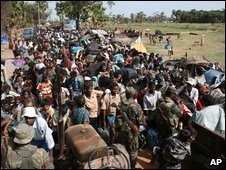Evidence gathered by The Times has revealed that at least 20,000 Tamils were killed on the beach by shelling as the army closed in on the Tigers
 “Deeply disappointing” was how a human rights group yesterday described the vote in the United Nations Human Rights Council hailing the victory of the Sri Lankan Government. This is a breathtaking understatement. It was an utter disgrace. The 47-member body, set up in 2006 to replace the previous corrupt and ineffectual UN Commission on Human Rights, has abjectly failed one of its first and most important tests.
“Deeply disappointing” was how a human rights group yesterday described the vote in the United Nations Human Rights Council hailing the victory of the Sri Lankan Government. This is a breathtaking understatement. It was an utter disgrace. The 47-member body, set up in 2006 to replace the previous corrupt and ineffectual UN Commission on Human Rights, has abjectly failed one of its first and most important tests.
It was asked by its European members to investigate widespread reports of atrocities and war crimes committed by both government troops and the Tamil Tigers in the final weeks of the conflict. The council chose instead to debate a one-sided, mendacious and self-serving motion put forward by the Sri Lankans. This welcomed the “liberation” of tens of thousands of the island’s citizens, condemned the defeated Tigers, made no mention of the shelling of civilians and kept silent on the desperate need to allow the Red Cross and other humanitarian groups into the camps where some 270,000 Tamil civilians have been interned.
Support for this deeply flawed resolution came from the usual suspects – China, Russia, India, Pakistan and a clutch of Asian and Islamic nations determined to prevent the council ever investigating human rights violations in their own or any country. It was sad to see Israel, for obvious political motives, joining in this charade, claiming that massacres, violence, repression and internment are an “internal affair”.
To her credit, Navi Pillay, the UN High Commissioner for Human Rights, insisted that there needed still to be an inquiry into “very serious abuses”. Those abuses, it now emerges, are far, far worse than the outside world imagined. The UN estimated that 7,000 people were killed in the first four months of this year; the figure now appears to be at least 20,000. Thousands of these victims died as a result of the shelling by the Sri Lankan Army of the strip of coastline where the final remnants of Tiger resistance were trapped, along with at least 100,000 civilians.
Photographs taken by The Times present clear evidence of an atrocity that comes close to matching Srebrenica, Darfur and other massacres of civilians. In the sandy so-called no-fire zone where the trapped Tamil civilians were told to go to escape the brutal army bombardment, there are hundreds of fresh graves as well as craters and debris where tents once stood. This was no safe zone. This was where terrified civilians buried their dead as the shells landed – after the Government had declared an end to the use of heavy weapons on April 27.
Some civilians were probably killed by the Tigers, whose brutality and ruthlessness over the past 28 years has fully justified their depiction as terrorists. Finding out what happened, however, is impossible: the army has barred entry to all outsiders. Food is short, sanitation appalling; wounded and traumatised civilians are in desperate need of help. That much is clear from those who have been able to escape. More sinister reports are now circulating of systematic “disappearances”, of families separ- ated and young men taken away. But until the Government allows in aid workers, the presumption must be that it wants nothing to be heard or seen of what is going on.
This tactic was used in the final push to beat the Tigers. The army wanted no witness to the onslaught, no journalists to alert the world to human rights violations, no photographers to record the suffering. Sri Lanka, now basking in its victory, may set the pattern for other nations battling against insurgencies. For them, victory is all that matters. Most of Sri Lanka may rejoice at the end of a bloody civil war. But the UN has no right to collude in suppressing the appalling evidence of the cost. The truth must be told.
(For updates you can share with your friends, follow TNN on Facebook and Twitter )
